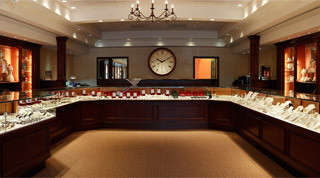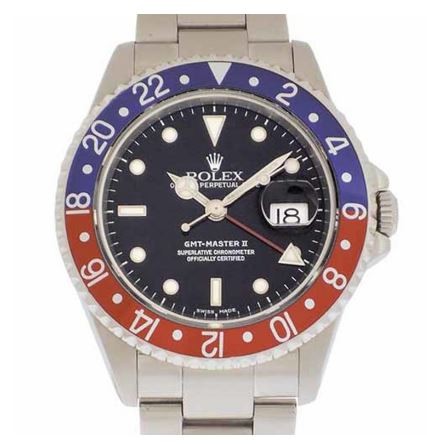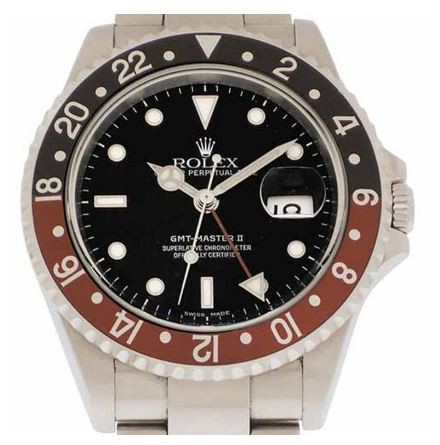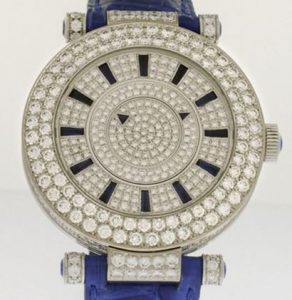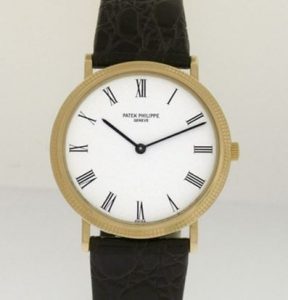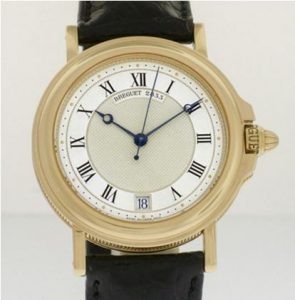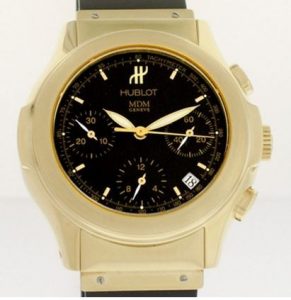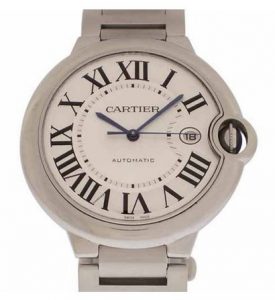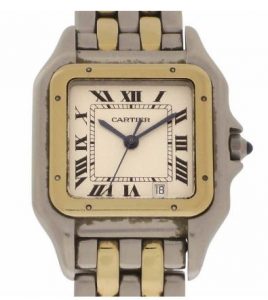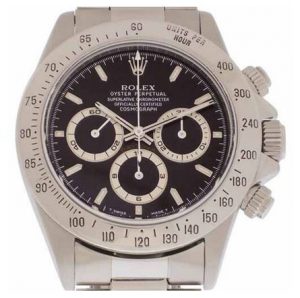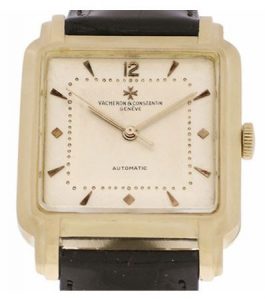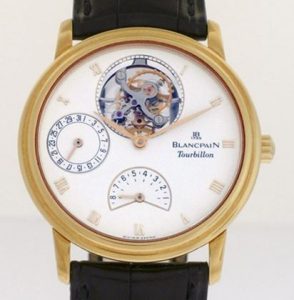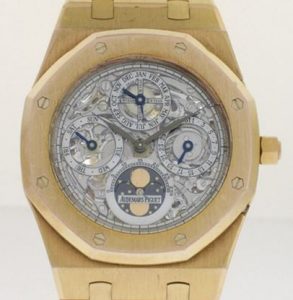We interviewed Ron Lieberman, owner of Palisade Jewelers for his expert opinions and advice on the second-hand luxury watch market to find out which watch brands hold their value when it’s time to sell. With his own store since the early 90s, and a family business going back generations, he knows the watch resale market backwards and forwards.
Which luxury watch brands resell best?
Dialog: Which watch will do best on the second-hand market? What are some of the eternal favorites for pawning, for reselling, what makes…I’m assuming Rolex watches are king.
Ron: Yes, I think the watch that’s most asked about, the most traded watch is clearly Rolex. And you see that by the amount of phone calls, we get, also if you read any statistics about Swiss watch sales, Rolex is clearly the most popular. And it’s probably one of the two best-known brands in the world along with Coca-Cola. If you really go anywhere in the world, you know, in the hills of Thailand, they know Rolex. I think every watch line really wants to be like Rolex.
Dialog: What do you think it means to be like Rolex? To do everything in-house? To innovate?
Ron: They have a tremendous factory and there have been some articles written about their process but they keep a lot of things secret. Like the accurate number of timepieces they produce.
And they have come up with ways to create metals and mix metals and even stainless steel. It’s a unique steel.
They were innovators with things like the screw down crown which makes the watch water resistant. That’s where the oyster name came from. And there are different parts of their movements that are definitely unique to Rolex.
Dialog: They come out with so many different kinds with small changes to the bezel, or the face, or the dial, or whatever. Is that so that they are harder to imitate? Or does that make it harder to certify a genuine one? Because I find it very difficult to find a guide to, “okay, this model should have this and this and this?”
Ron: I think they do make changes to thwart the copiers but, there are people making copies, making really, really good copies. Rolex is one of the brands that is definitely hard to copy exactly. They have many attributes that are better, really, really hard to copy.
But I think they make them because they want to increase the sales, and they make some subtle changes within a particular model.
The Rolex Mystique
Ron: The question is, let’s give them that they were innovators in watch making, but what made Rolex became the status symbol that it is?
Because the reality is, people buy a gold Rolex and they’ll say how much gold is in it? Or, is the high price because of all the gold? And I point out that my stainless steel Daytona has zero ore material value but it’s still worth $15,000. So is it the status? Something about it makes it desirable everywhere.
Rolex is an incredible phenomenon. Fans even name watches after certain pop culture figure like the green dial submariner with the green bezel that’s nicknamed ‘The Hulk’. Rolex didn’t do that but people know it is ‘The Hulk.’ There’s a watch that’s a Rolex GMT that has a black and blue bezel and people know that as ‘Batman’. We wrote an article about that with Coca-cola and Pepsi and Root beer. And there’s a deep sea diving watch with a dial that fades from blue to black and it’s known as ‘The James Cameron’ because he did The Titanic.
Dialog: Oh, that’s cool.
Ron: It’s just amazing. Omega has that celebrity status with James Bond.
Dialog: Right. And the ‘Moonwatch.’
Ron: Well the ‘Moonwatch’ is not named after someone, it really went to the moon. The Omega’s Speedmaster to me really is the most interesting limited edition or commemorative watch because it signifies a really true monumental event.
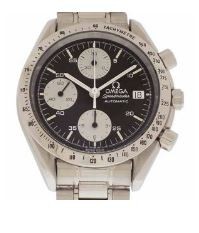
Changing hands: how the value of watch brands owned by other companies is affected
Dialog: So one of the theories that I have about the status of Rolex is that, as you read the stories of different brands, so many went in and out of ownership. They’re great brands that sometimes, you know, one family held it for a long time and then it went under and sometimes somebody else bought it who brought it back, but you’ll have sort of this middle period where they’re not nearly what they were. Meanwhile, Rolex has maintained independence and a consistency over the years that I don’t think is replaceable. So, do you think that figures into it?
Ron: I’m sure there are other brands that are like that but Rolex has maintained its independence from some companies that own other watch companies. There’re all these groups. Like there’s a Swatch group with 20 or so brands, good ones, like Omega, Breguet, Tissot others, and then there are other watch companies that got bought by a big conglomerate.
Rolex is independent and it stayed true to its founder’s wishes. It’s registered as a non-profit in Europe.
Dialog: The Hans Wilsdorf Foundation.
Ron: Yes, and then, of course, some owners of companies and founders definitely have had trouble with some very good brands. Like Franck Muller. In the ’90s, the watches were winning all sorts of awards for design and function and watch making. He was like a Nobel Prize winning watch maker.
And I think he got into problems. There were all sorts of stories about what was going on with him in Europe and the company, and that seemed to affect the way the company was perceived and the way it was distributed and whether it was staying in business or going out of business.
Patek Philippe customer service stands out
But there’s another interesting thing with brands that I find. Look at Patek Philippe. What makes them unique is that the company really honors the people who own the watch. So if you go to Patek Philippe with a watch and you want to get it serviced, while you’ll pay through the nose, you’re respected for owning the Patek. And they don’t care where you bought it or how you got it because they know that Pateks are given, passed down from generation to generation, that’s part of their marketing. You don’t own it, you just you just are holding on to it…
Dialog: …for the next generation.
Ron: And that keeps the secondhand market strong.
Dialog: If you can find one.
Ron: Yes, right now, there isn’t a massive amount of product out there so people who want to buy second-hand find that Patek volume is way down. The people who want to buy a $100,000 Patek today are not looking necessarily for a bargain at $60,000, they’ll pay the $100,000, or they’ll get a little discount, pay a little bit less.
And the people who want to sell them and have them think that they should be getting more but the market is really around 45 or 50.
Dialog: So volume on Rolex is up, Patek is not. Is that an indicator of uncertainty in the market?
Ron: No. I think they’re fewer and fewer pieces of Patek available and honestly, Patek Philippe is more of an investment watch and…
Dialog: Meaning what? I thought Rolex was.
Ron: I don’t think people look to really sell and trade Patek Philippe’s the same way that they do Rolexes. People will trade up Rolexes. There are many more pieces made per year, the volume in Rolex is much higher than Patek Philippe.
Which watch brands trade well on the second-hand market?
Ron: Patek is a much more exclusive watch. But there are other watches that have been popular trading and don’t seem to be as popular now like Hublot, Audemars Piquet. Copying has hurt them. There are some very good copies out there. And Audemars Piquet had a lot of celebrities that made it really popular, but then that sort of died down. Even Panerai was worn by certain celebrities like Sylvester Stallone, and now it’s not as popular.
Dialog: What about Vacheron?
Ron: Nice watch. Pretty watch. I don’t think the name means that much anymore. Once upon a time, you used to say the three best watches were Patek, Audemars, and Vacheron. And from a watch making point of view that still may be true.
IWC has made a resurgence in recent years. It has become much more popular. Clean faces, classic design, pilot watch look. But Vacheron…is exclusive. They’re nice watches but I don’t think they have the chic value. You know watches like Audemars took off also…the hip-hop world sets a lot of trends so Hublot and Audemars Piguet with diamonds were rapped about a lot. And that makes them popular. Vacheron seems more old money to me. It’s certainly not a hip hop watch.
Dialog: What about Breguet?
Ron: Breguet the same. You don’t tend to see young people wearing Breguet. I think Breguet makes beautiful watches. Their hand, numbers, faces. Breguet is a really great watch. I don’t see that many in the used world.
The watch market is worldwide
Dialog: How do you know what the market is gonna be? I’ve seen a couple of websites where people are trying to do an indication of the value of a certain watch but, I’m not sure how reliable that is.
Ron: You know now it’s such a worldwide market. I deal with some dealers in the Russian world and the Russians several years ago were going crazy for Ulysse Nardin or models that watch companies were not making multiple pieces of, or very few pieces of. They wanted watches that were $100,000 and there were only 100 of them made kind of thing. And they liked Ulysse Nardin and Roger Dubuis and…I never really sold that many of those watches. But Russian watch dealers were sending a lot of watches overseas.
Now the Russians don’t seem to be buying as much, there doesn’t seem to be as much trade. Hublot became the most popular watch in Spain. I don’t know that it is carrying the market for Hublot anymore, it’s not as popular here.
So the worldwide markets affect different markets, affect what watches I sell and when. In The United States, we’re like, you know, there are certain watches that are very popular in the Asian world.
Usually, the Asian market, once upon a time the Japanese were buying all of these mid-sized Rolexes for men. Now it’s women who are buying mid-sized and larger Rolexes here. But the Japanese economy isn’t like it was. So as the economy of different countries become stronger and more influential, the watch buying takes effect.
Like several years ago, we were shipping a ton of watches to Hong Kong, China. So here they were making all the fakes but the people with money, the rising middle class in China, wanted the real thing. A lot of people were buying watches here and taking them to China, selling them in Hong Kong. That seems to have died off. The Chinese government had a crackdown on gift giving. So this all affected which watches were popular. But it seems whatever happens in the world, Rolex stays strong.
After Rolex, which watch brands rule the second hand market?
Ron: Well, a watch that has always had a strong second market is Cartier. Now Cartier isn’t just necessarily known as a watch company, it’s a jewel company. Many of their collections that became popular sell well in the second-hand market. Ballon Bleu is a watch line that has a strong used market. Tank Française when it first came out, the first few years was very popular. And even certain watches like The Roadster which is not made any more is popular on the secondary market.
And probably the most popular Cartier of all time was the Panthère. There was Panthère jewelry and the Panthère watches, but they discontinued the Panthère so there has always been a market for the pre-owned Panthère because they stopped making it. And now just this year they reintroduced the Panthère! So I don’t know what will happen. But a new style gold Panthère retails in the $30,000 range and we at one time had pre-owned Panthères that we couldn’t sell for $5,000, $6,000. So I don’t know what’s gonna happen to the old style pre-owned Panthères.
Dialog: So there’s no telling if let’s say a new issue is going to push a brand…it’s going to raise awareness.
Ron: Yes. So it probably will because the whole thing with the Panthère, every year that the Panthère was discontinued, fewer and fewer people knew what the Panthère was. But the Panthère, the Santos, they are the lines of Cartier that people do ask for used. So I would say after Rolex, pre-owned watches would be Cartier, Brietling, Omega.
Factors that influence second-hand watch prices
Ron: Interestingly enough, Amazon, in their new pre-owned watch category, the five brands that they want to emphasize are Rolex, Cartier, Breitling, Omega, and TAG Heuer. Because the price point Amazon wants is between $2,000 and $5,000. That’s their sweet spot.
Discounts affect the second-hand market, too. For example, there used to be a small used market for Movado. But today, Movado are so discounted, there’s no used market. Because the money we have to put into it to make it saleable, we’re never going to get out of it. By the time we pay 200 to 400 to fix it up and make it look like new, whether we have to change the strap or refinish the watch or clean the movement, after we put that money into it, we want to be able to sell it and still get something out of it.
Buying a watch as an investment piece
Dialog: Has there been any shift on the customer side with people thinking about a watch like an investment piece? Are there some brands that are more collateral and some brands that are more emotional?
Ron: No one really knows which watch is going to be the next Rolex Daytona, and Rolex Daytona is one of a kind. The Rolex Daytona in stainless steel sells for over the list, the old Rolex Daytona are thousands more than they were at purchase.
I think Patek is an investment watch but even if you buy a new Patek, at list price or a little bit less than list, chances are that if you sell that watch within 5 to 10 years, you’re going to take a hit.
So there’s the investment part of it but it is emotional. And it has to be looked at as art. If you just look at the utility of a watch, it’s ridiculous. You can tell time with your cell phone, or a digital watch that costs nothing, but the emotional appeal, the mechanical appeal, the engineering part of a watch definitely affects how people look at it and whether they want to spend money on it. Think about it. A complicated Patek Philippe takes a watchmaker a whole year, putting it together. And it’s handmade. That’s art. But the overriding factor in the appeal of Rolex and I think other watches is still status.
Should you invest in a limited edition watch?
Dialog: When places like the stores in Macau or the Wynn hotel open, brands will make celebratory one-off editions, let’s say they make 100 or whatever. Is that a separate market? Is there a desire for those?
Ron: Every company has come out with limited edition watches. They all have limited editions. They try to make a limited edition to commemorate certain events like Olympics or different air forces or they try to tie into marketing to a movie or an event. I’m not in that world.
Dialog: That’s not a strong part of the secondary market?
Ron: Maybe it has its own market out there. Maybe people want watches from events but I think the marketing hype is more than the actual interest. They want to have that interest but I don’t see it day to day.
How do trends affect resale of popular watches?
Dialog: So in terms of second-hand watches that you could sell all day all night, what’s trend-proof?
Ron: Daytona, any Rolex sport watch, Rolex President. And people want them in all metals. Stainless steel, stainless and gold, all gold. There was a time that white gold and platinum were really popular. Everyone was going to white metals. I would say that that trend has certainly reversed. Which doesn’t mean there’s no interest in white gold and platinum but people spend less and wear stainless steel and if they wear gold they want it to be known that it is gold. They want yellow gold, or rose gold. On the other hand, I have a list of a couple of people who want platinum Rolex Presidents because they want it but they don’t want anyone to know that it’s that expensive!
A watch that sets you apart
Ron: And that’s also the interesting thing with watches. There’s a customer for almost everything. Like I don’t see the popularity in Breguet and Vacheron but the person who’s wearing it wants to have something that’s unique. That’s the knock on Rolex, that it’s mass produced high-end status. You see a lot of Rolexes out there.
But if you’re wearing a unique Vacheron, unique Breguet, Audemars, it’s going to have some personality.
Dialog: Especially for men, who don’t have so many different style choices for themselves. You’ve got a watch, you’ve got a couple of ways to show your personality but really not as many choices as women do.
Ron: You know you go to that black tie affair, you go to that party, you go to that art opening. You pull up in the Lamborghini and the valet parks it. For the four hours in the event, no one sees the Lamborghini! But you’re always wearing your watch!
You know, I hear from men say that when they go to a board meeting, they go to some kind of meeting, someone’s wearing a Blancpain which not everyone has. And then it creates an opening, a conversation with people. Someone will say, “Hey, that’s a really nice watch.”
You know no one says, “Oh, I like your Apple watch” and they say, “Oh, I like your Apple watch too.”
Dialog: What about some of the oddly shaped pieces? Do those appeal for the same reason?
Ron: Sure, and even on a basic level people will come and say, “I don’t like round watches, I want a square watch.” And then there are people who really like something that’s octagonal or asymmetrical or something that makes it unique. Like the Audemars Piquet Royal Oak Offshore watch is octagonal. So people are looking for something that’s a little unique or shows some personality or has some emotional appeal.
Ferreting out a fake watch
Dialog: With all the changes in watch styles, how do you know the fakes?
Ron: Experience. Years of looking at watches, of following the market.
Everyone thinks they have all this knowledge because of the internet but like I said, Rolex and others don’t want you to know everything.
I had a guy come in the other day and he wasn’t trying to fake me out, he just said, “What do you think of this watch?”
And I said, “It’s a fake.” It said Rolex on the dial and it had a day and date window and it had this sort of steel blue color face which is the unique dial to the platinum President watch.
And so I said, “that’s a nice fake.” He said, “How did you know?” I said, “Well, one, your watch has what’s supposed to look like a Jubilee bracelet. And your blue is a little darker than the blue that comes on the watch.” And he said, “But, if you didn’t know that you wouldn’t know the difference.” I’m like, “Yeah, but, I know. And anyone who knows, knows.”
Dialog: Well it’s clear that you know. Thank you for sharing your watch expertise.
Ron: My pleasure.


TESTIMONIAL
“My experience buying a pre-owned Rolex from Palisade Jewelers was perfect. I did the transaction by phone. The watch arrived, exactly as described; they gave me good, attentive service.”
– Richard
CALL OR COME
SEE US
Visit our store for a personal consultation with our watch and jewelry experts.

